Postumus, Romano-Gallic Emperor
- sulla80

- Sep 18, 2021
- 5 min read
Updated: Mar 2
The coins of interest today are not Roman republican. They are from a time period that that has interested me from my first coin: a worn sestertius of Valerian.

I have a small sub-collection of coins from the reign of Gallienus. Postumus was a usurper in the East after Emperor Valerian, father to Gallienus, was captured and humiliated by Sasanian King Shapur I. See the related note on Gallienus and Usurpers in AD 260. This coin is a good example of the challenges in deciding what to pay or how to price an ancient coin - there are many factors to consider that all contribute to "what someone will pay for this coin". See another related note on "Calculating the Price".
Here's an example that is particularly challenging to price - there are not a lot of "double sestertii" - it was a denomination that was first issued by 3rd century AD Emperor Trajan Decius and then Postumus as usurper in Gaul.
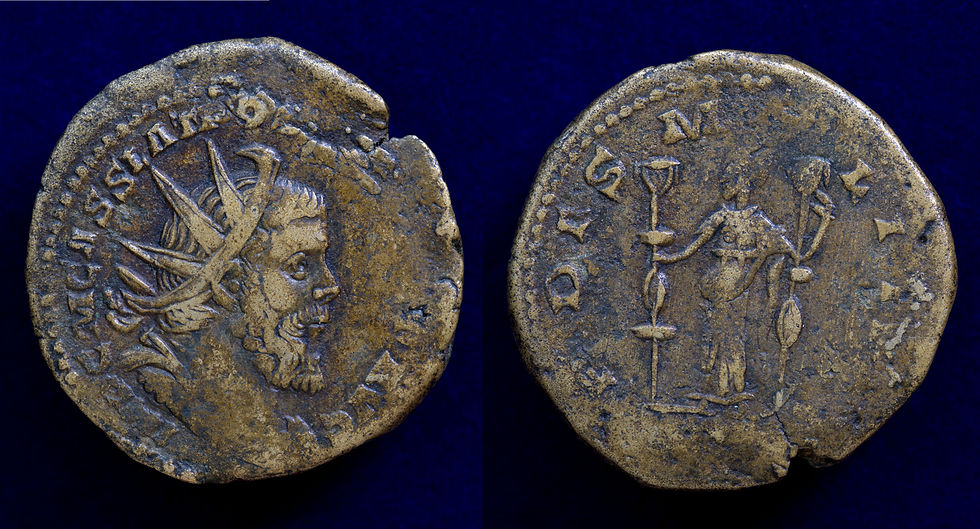
Postumus, Romano-Gallic Emperor, AD 260-269, Æ Double Sestertius (32 mm, 18.07 g, 6h), Treveri (Trier) mint, 3rd bronze emission, struck AD 261
Obv: IMP C M CASS LAT POSTVMVS P F AVG, radiate, draped, and cuirassed bust right
Rev: FIDES MILITVM, Fides standing facing, head left, holding signum in each hand.
Ref: RIC V 123;
ACSearch has ~90 examples that have sold from $3250 to $39 in auctions over two decades from 2001 and 2021. Here's a selection across that price range:
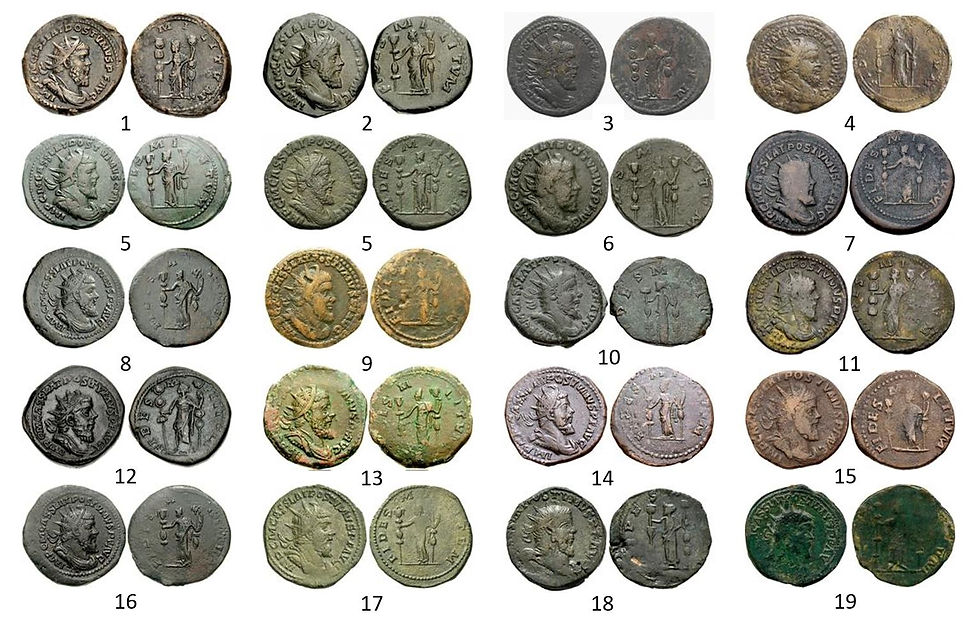
The average price of all 68 that had a hammer price in the set that I found is about $360 and the median about $250. The highest prices seem to have been in the 2010-2015 range. The most expensive coin sold for $3250+buyer's fees. This highest priced coin is a bit exceptional in weight at ~32 grams. The least expensive in the set above is $60+buyer's fees at about 18g. Can you pick out the best or the worst?
There is a thesis by Jerome Mairat, supervised by Chris Howgego and Roger Bland, that provides an excellent overview and catalog of the coins of Postumus, summarizing past scholarship, putting in context debates about mints, metrology, and chronology and cataloging the coins. It is an impressive work, and for anyone interested in this time period or these coins it is an essential read. The two mints for Postumus are Cologne and Trier and in 2005 archeological evidence was found for the mint of the Gallic Empire at Trier. Mairat is a contributor to the revised edition of Roman Imperial Coinage. The obverse of my coin is a die match to a coin in Mairat's catalog coin 133/72 which originated from CNG 64, Lot: 1191 Sept 2003.
The double sestertii of Decius was ~35.45g while Postumus' double sestertii average 21.40g - during a period of rapid inflation. The coins were often minted on worn sestertii of earlier Roman emperors. There would have been a financial incentive to double the value of a worn sestertius with a fresh strike of a radiate double sestertius. Noticeable as well that there is no "S.C." Senatus Consulto on these bronze coins.
These coins were larger than expected P. H. Webb (1933) noted that they seemed to be double the sestertius, and P. Bastien (1967) did a study of the weights to show that radiate coins were heavier than laureate sestertii and hence named them "double sestertii", Mairat notes that the probability for Postumus is only 35% that a double sestertius will be the same or heavier than a sestertius. Given this it is perhaps not surprising that there are sestertii of Postumus that were altered to add a radiate crown - an easy way to double the value of your money. This may also have been a factor in the discontinuation of these coins in 261-262.
The broad thin flan and some not quite clear evidence of an under-type suggests to me that this coin may have once been a sestertius of a predecessor - but not enough visible to be certain. The coin has an excellent portrait style with nice relief, and is on a large flan with relatively complete legends.
A series of unofficial double sestertii of Postumus started being issued almost at the same time as official coins.

A CNG Example of a fairly unconvincing contemporary counterfeit of Postumus (see: CNG Research Database).
Here is my sestertius of Postumus, appropriately it is quite a bit heavier than a typical double sestertius at 23.35g. Note the lack of spiked crown.
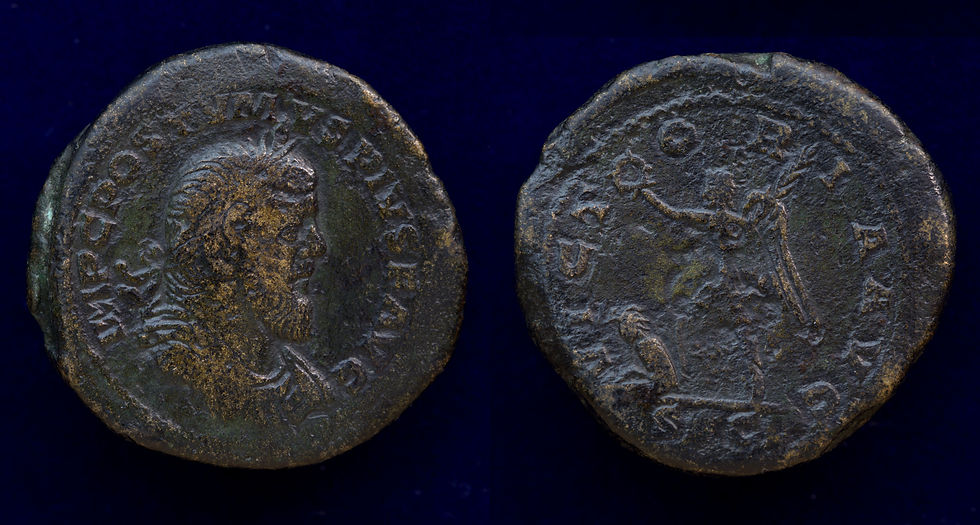
Postumus, Romano-Gallic Emperor, AD 260-269, Æ Sestertius, Treveri, AD 261
Obv: IMP C POSTVMVS P F AVG, laureate, draped and cuirassed bust to right
Rev: VICTORIA AVG, Victory advancing to left, holding wreath and palm, captive at feet to left
Ref: RIC V.2 170
Here's another coin for Postumus - a billion Antoninianus also from Treveri/Trier which tested as ~30 percent silver. (Mairat's catalog 264 or 265)
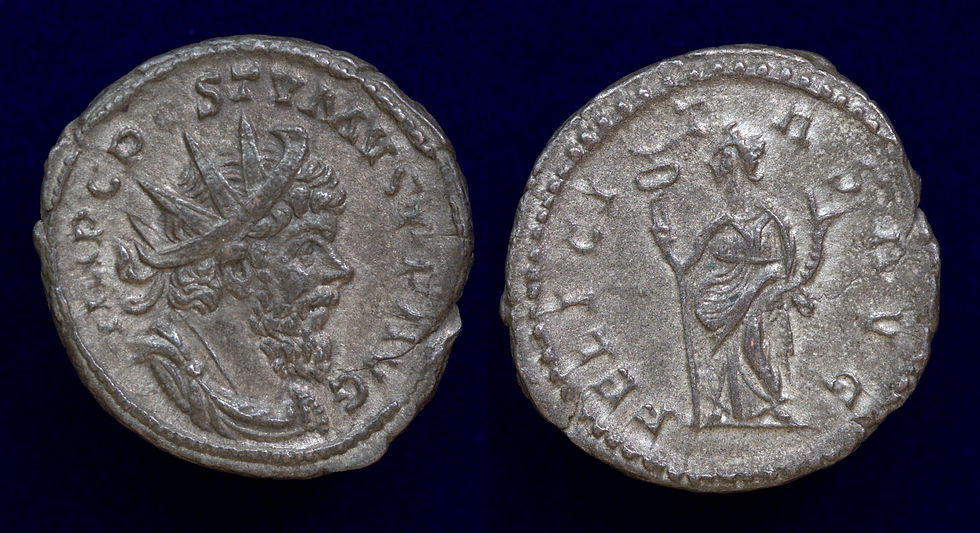
Postumus, Romano-Gallic Emperor, AD 260-269, AR Antoninianus (21.6mm, 4.76g, 6h). Treveri / Trier, issue 5 c. mid – end 263 (Cunetio series 3, phase 1)
Obv: IMP C POSTVMVS PP AVG, radiate, draped, and cuirassed bust right
Rev: FELICITAS AVG, Felicitas standing facing, head left, holding long caduceus and cornucopia
Ref: RIC V 58;
The next two coins were minted in the name of Postumus by Aureolus. Aureolus, was Magister Equitum, head of the cavalry, for Gallienus and betrayed him, striking coins in the name of Postumus’ name.

"Aureolus, who as we have already said in command of the cavalry and possessed great power, formed a new conspiracy against Gallienus, seized Milan and prepared for battle. The emperor having amassed all his forces and charged the rebel's troops, cut to pieces a large number, even wounded Aureolus and forced him to shut himself up in Milan where he besieged him ..."
- Zonaras (writing in the 12th century AD), Gallienus
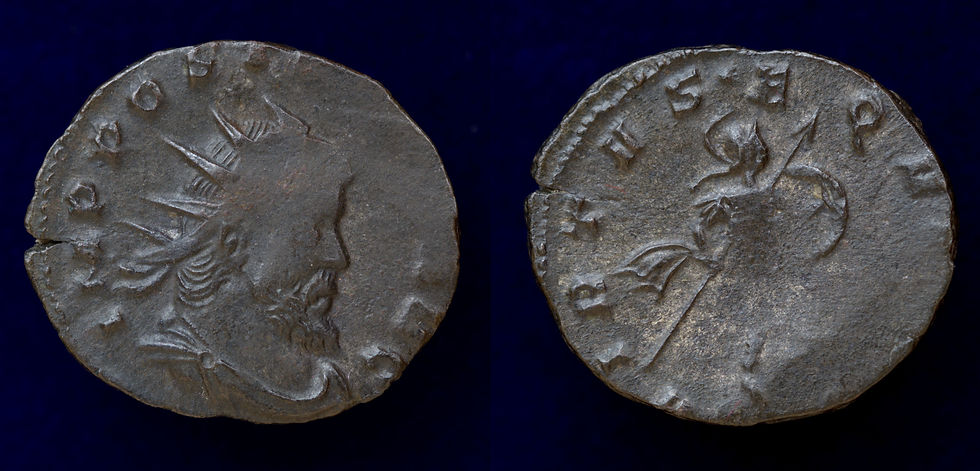
Aureolus, Romano-Gallic Usurper, AD 267-268, Antoninianuas, Mediolanum (Milan) mint, 3rd officina, struck in the name of Postumus, 3rd emission, mid AD 268
Obv: IMP POSTVMVS AVG, radiate, draped, and cuirassed bust of Postumus right
Rev: VIRTVS EQVIT, Virtus advancing right, holding transverse spear and shield; [T]
Ref: RIC V (Postumus) 388; Mairat 222-7
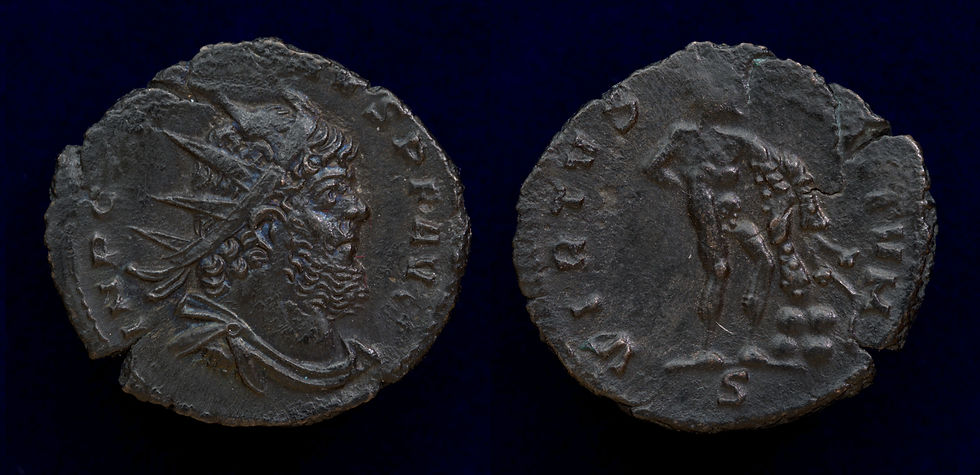
Roman Empire, Aureolus struck in the name of Postumus, Mediolanum (Milan), 267-268, Antoninianus
Obv: IMP C [POSTVM]VS P F AVG, radiate, draped, and cuirassed bust right
Rev: VIRTVS [EQVI]TVM, Hercules standing right, lion skin over left arm, leaning on club propped on rocks to right, S.
Ref: Cunetio 2497
Around AD 258, Gallienus gave Aureolus command of a new cavalry unit at Mediolanum (Milan) - his position recognized on the reverses of these two coins. Aureolus was a capable general responsible for the defeat of Macrianus, a usurper in the East. At some point in AD 267 Aureolus revolted - first aligning himself with Postumus and then declaring himself emperor. He was defeated by Gallienus in 268 and that summer Gallienus was killed and Claudius II Gothicus declared emperor.
References
GRICOURT, DANIEL, and DOMINIQUE HOLLARD. "Les Productions Monétaires De Postume En 268-269 Et Celles De Lélien (269). Nouvelles Propositions." The Numismatic Chronicle (1966-) 170 (2010): 129-204.
Pierre-Marie Guihard. Monnaie de bronze du Haut-Empire surfrappée découverte à Alauna 1 (Valognes, Manche). Retour sur le “ double sesterce ” de Postume. Annales de Normandie, Association, Les Annales de Normandie 2015, pp.105-115.
The Cunetio and Normanby Hoards, Roger Bland, Edward Besly, Andrew M. Burnett, Spink & Son Limited, 2018, 304 pages.
Jerome Mairat, 2014, Doctoral Thesis, The Coinage of the Gallic Empire, Oxford University, UK.
Ioannes Zonaras, "Historia di Giovanni Zonara", newly translated by Marco Emilio Fiorentino from Greek, and published 1560 AD by Ludovico de gli Auranzi.
CoinWeek, Mike Markowitz, January 26, 2024, Breakaway Empire: Coins of the Gallic Emperors
RIC v. 4 The Gallic Empire, Jerome Mairat now available from Spink




Sulla, Another interesting article with excellent illustration 😊. Since sestertii more often than not weigh more than double sestertii, & both coin types are commonly struck over existing sestertii, the weight of these coins have no relevance to their purchasing power. Finding fully struck examples of both coin types with all details visible is nearly impossible 😏. After searching many years for a sestertius that I'd be happy with, I finally scored a nice example early this year that's been posted a number of times 🤗. Thanks for posting the link to the Doctoral Thesis by Jerome Mairat. When the winter months hit upstate NY, & I turn into a "house mouse" 🐁, I'll enjoy reading it.